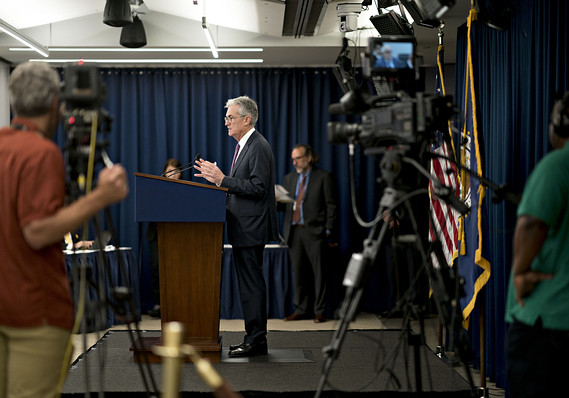 Bloomberg News/Landov
Bloomberg News/Landov
Economists are broadly expecting the Federal Reserve to lower its benchmark interest rate this week by a quarter-point, the first cut in 10 years.
With an easing seemingly a fait accompli, economists are turning their focus to the future. How will Fed Chairman Jerome Powell and his colleagues communicate their plans? Will they be hawkish and indicate a “one-and-done” rate cut? Will they leave the door open for another move in the fall? Or will they match the market’s dovish leanings?
The Federal Open Market Committee, the central bank’s interest-rate body, will meet Tuesday and Wednesday. They will release a decision at 2 p.m. Eastern time at the end of their two days of talks and Powell will hold a press conference at 2:30 p.m.
Read: Fed still has ‘green light’ to ease after second-quarter GDP
Investors have been fairly certain about a rate cut since the June meeting. They have priced in almost 70 basis points of easing through year end, according to CME Group’s FedWatch tool.
Over the past month, the yield on the 10-year Treasury note TMUBMUSD10Y, -0.68% has not moved much at all. It was trading around 2.078% late Friday. The Dow Jones Industrial Average DJIA, +0.19% has risen 2% since the beginning of the month.
Here are five things that economists are watching for when the central bank announces its decision.
1. How large a cut? Most, but not all, economists expect a quarter-point cut. Seth Carpenter, U.S. chief economist at UBS is in the half-point camp. He thinks there is merit to a go-bigger and go-sooner strategy.
See: Powell testimony leaves Fed watchers scratching their heads
2. How assured is their view of the economic outlook? The first paragraph of the Fed’s policy statement usually “marks to market” how the economy has performed over the previous six weeks, so it is not usually the most analyzed part of the communication. But at this meeting, economists will be watching to see how gloomy or upbeat the Fed is about the recent economic data. “If they write down something gloomy, it means they are inclined to do more” with rates, Carpenter said.
3. How does the Fed “frame the narrative” over future moves? Many economists don’t think the Fed will pre-commit to another rate cut in September. Tom Simons, money-market economist at Jefferies, said it would be easier to hold off signaling a rate cut for now, because the central bank can always wave the flag later. In fact, it is always harder to tell the market you are planning to ease and then pull it back, Simons said.
See: Fed blown off course by Trump tweets
Matthew Luzzetti, chief U.S. economist at Deutsche Bank Research, said Powell will frame the cut as “insurance” against the potential of a more significant downturn. “The implication of this framing would be that the committee is maintaining an easing bias in the coming months, with the onus on the crosscurrents to dissipate and data to materially improve to avoid another cut in September,” Luzzetti said.
4. Any change to balance sheet run-off? Economists seem split about any changes to the central bank’s plan to shrink its balance sheet, which has been a form of tightening its post-crisis, ultra-loose policy. That plan is already set to end in September, but some economists think the Fed will end it early to keep policy consistent. Other economists think the Fed wants to keep the balance sheet in the background.
5. Dissent? Fed watchers expect two dissents should the committee opt to cut — from Kansas City Fed President Esther George and Boston Fed President Eric Rosengren. “Both appear to favor a ‘wait-and-see’ approach in evaluating risks to the outlook,” said Michael Gapen, chief U.S. economist at Barclays. “Two dissents are relatively rare, but not entirely unusual; this occurred recently in December 2017 and November 2016,” Gapen noted.






